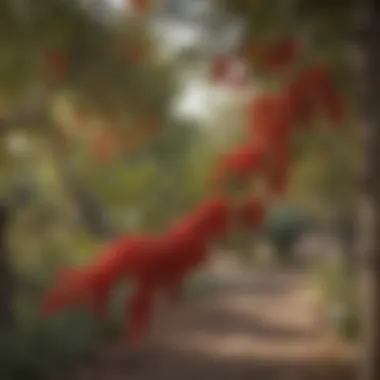Unveiling the Impact of the Brazilian Pepper Tree in Arizona's Ecosystem


Evergreen Trees Species
When it comes to exploring the lush landscapes of Arizona, understanding the diverse array of evergreen tree species that abound in this region is essential. From the majestic Ponderosa Pine to the resilient Juniper and the iconic Douglas Fir, each species holds a unique place within Arizona's ecosystem. This section will delve into the types of evergreen trees that grace American forests, highlighting their individual characteristics and contributions to the local ecology.
Ecological Significance
The ecological importance of evergreen trees in Arizona cannot be overstated. These trees play a vital role in maintaining biodiversity, providing habitat for wildlife, and stabilizing the local ecosystem. Through their year-round green foliage, evergreens offer continuity in oxygen production and serve as resilient guardians against soil erosion. Additionally, their ability to withstand harsh environmental conditions makes them key players in preserving Arizona's unique flora and fauna.
Conservation Practices
Effective conservation practices are crucial for safeguarding the future of evergreen tree species in Arizona. Implementing sustainable logging methods, promoting reforestation initiatives, and monitoring tree health are all essential steps in preserving the ecological balance. By exploring conservation techniques tailored to the specific needs of evergreen trees, forestry professionals can actively contribute to the long-term sustainability of Arizona's forests.
Introduction
Background of the Brazilian Pepper Tree
The Brazilian Pepper Tree, scientifically known as Schinus terebinthifolius, is an invasive plant species native to South America. Introduced to Arizona as an ornamental plant, it quickly spread through the state's landscapes, outcompeting native vegetation and disrupting the ecological equilibrium. The Brazilian Pepper Tree is characterized by its dark green leaves, red berries, and distinctive peppery scent. Understanding its origins and rapid proliferation is essential in devising effective management strategies to curb its impact on Arizona's biodiversity. By examining the historical trajectory of this species, we can comprehend the underlying factors contributing to its invasiveness and ecological repercussions.


Origins and Description
Native Habitat of the Brazilian Pepper Tree
Diving into the native habitat of the Brazilian Pepper Tree unveils crucial insights into its ecological preferences and interactions with the surrounding environment. This invasive species typically thrives in semi-arid to humid climates, showcasing a preference for well-drained soils and ample sunlight. Its ability to outcompete native vegetation for resources highlights the importance of understanding its habitat requirements to effectively mitigate its spread. By examining the specific microclimatic conditions that favor the Brazilian Pepper Tree's growth, we can develop targeted management strategies to limit its proliferation in Arizona.
Physical Characteristics of the Brazilian Pepper Tree
Exploring the physical characteristics of the Brazilian Pepper Tree offers a closer look at the traits that enable its successful establishment and reproduction in new habitats. With its glossy green leaves, small white flowers, and red peppercorn-like fruits, this tree presents a striking appearance that distinguishes it from native flora. Additionally, its rapid growth rate and ability to form dense thickets make it a formidable competitor in Arizona's natural landscapes. Understanding these physical attributes is crucial for timely identification and control measures to prevent further encroachment of the Brazilian Pepper Tree in vulnerable ecosystems.
Spread and Impact in Arizona
In this section, we delve into the crucial topic of the spread and impact of the Brazilian Pepper Tree in the intricate ecosystem of Arizona. Understanding the dissemination and consequences of this invasive species is paramount to safeguarding the native flora and fauna of the region. By spotlighting the repercussions of the Brazilian Pepper Tree's presence in Arizona, we aim to underscore the urgency of effective management strategies and heightened ecological awareness.
Introduction of Brazilian Pepper Tree in Arizona
The Brazilian Pepper Tree, scientifically known as Schinus terebinthifolius, made its entry into Arizona through horticultural introduction. Initially cultivated for its ornamental foliage and berries, this species quickly outcompeted indigenous plants due to its rapid growth and prolific seed production. The instance of the Brazilian Pepper Tree's introduction in Arizona precipitated a cascade of ecological disruptions, altering the landscape and challenging the existing biodiversity.
Ecological Impact on Native Species


The ecological impact of the Brazilian Pepper Tree on native species in Arizona is profound and multifaceted. By forming dense thickets that inhibit sunlight penetration and deplete soil moisture, this invasive plant outcompetes native vegetation, leading to reduced plant diversity and habitat degradation. Moreover, the allelopathic compounds released by the Brazilian Pepper Tree inhibit the germination and growth of native seeds, further exacerbating its detrimental influence on the local ecosystem.
Challenges Faced in Managing Brazilian Pepper Tree in Arizona
Effectively managing the Brazilian Pepper Tree in Arizona presents several challenges, stemming from its aggressive growth patterns, resilience to control measures, and extensive root system. Traditional management approaches such as herbicide application and mechanical removal often yield limited success due to the plant's ability to regenerate from root fragments. Additionally, the widespread distribution of the Brazilian Pepper Tree across diverse habitats complicates management efforts, necessitating a collaborative and adaptive approach to combat its proliferation.
Management Strategies
In the realm of exploring the Brazilian Pepper Tree in Arizona, an integral focal point lies in understanding and implementing effective Management Strategies. This segment serves as a linchpin in mitigating the detrimental impact of this invasive species on Arizona's native flora and fauna. Management Strategies encompass a variety of techniques aimed at controlling and ultimately eradicating the Brazilian Pepper Tree from ecosystems where it poses a threat.
It is crucial to recognize the urgency of developing and employing comprehensive Management Strategies to curb the proliferation of the Brazilian Pepper Tree in Arizona. Through meticulous planning and strategic execution, these strategies play a pivotal role in safeguarding the biodiversity and ecological balance of the region. Furthermore, the implementation of proactive management approaches can help prevent the Brazilian Pepper Tree from outcompeting native species, thereby preserving the delicate equilibrium of Arizona's natural habitats.
One significant benefit of emphasizing Management Strategies in this discourse is the ability to foster a sense of environmental stewardship among local communities and stakeholders. By elucidating the importance of adopting sustainable practices and responsible land management techniques, individuals can actively contribute to the preservation of Arizona's unique ecosystems. Moreover, addressing the challenges posed by the Brazilian Pepper Tree through effective management reinforces the collective commitment to conservation efforts and wildlife protection within the state.
In navigating the complex landscape of Brazilian Pepper Tree infestation, considerations about Management Strategies must take into account the interdisciplinary nature of invasive species management. Collaborative efforts between governmental agencies, environmental organizations, and research institutions are instrumental in formulating holistic strategies that encompass biological, chemical, and mechanical control methods. By integrating diverse expertise and resources, a synergistic approach can be adopted to tackle the multifaceted challenges posed by the Brazilian Pepper Tree invasion in Arizona.
Community Awareness and Involvement


Community awareness and involvement play a pivotal role in addressing the challenges posed by the Brazilian Pepper Tree invasion in Arizona. By raising awareness among local communities and engaging them in removal and management efforts, significant progress can be made towards controlling this invasive species. It is essential to educate residents about the negative impacts of the Brazilian Pepper Tree on native flora and fauna, emphasizing the urgent need for collective action.
Educational Initiatives on Brazilian Pepper Tree
Educational initiatives focusing on the Brazilian Pepper Tree are crucial for enhancing public awareness and understanding of this invasive species. These programs can include workshops, seminars, and educational materials that highlight the dangers posed by the Brazilian Pepper Tree and provide information on effective control methods. By empowering individuals with knowledge, educational initiatives can spark interest and encourage proactive involvement in combating the spread of this invasive plant.
Volunteer Programs for Brazilian Pepper Tree Removal
Volunteer programs dedicated to Brazilian Pepper Tree removal offer a hands-on opportunity for community members to contribute to environmental conservation efforts. These programs provide training on proper removal techniques and foster a sense of environmental stewardship among participants. Engaging volunteers in tree removal activities not only helps in controlling the spread of the Brazilian Pepper Tree but also cultivates a sense of pride and ownership in preserving Arizona's natural habitat.
Future Prospects and Conclusion
In this pivotal section of the article on Exploring the Brazilian Pepper Tree in Arizona, we delve into the crucial aspect of Future Prospects and present a compelling Conclusion. Understanding the prospects for controlling the Brazilian Pepper Tree in Arizona is imperative for devising effective management strategies and conservation efforts. By evaluating the current trajectory of this invasive species and contemplating future scenarios, we can better protect Arizona's diverse ecosystem and native flora.
Exploring the Future Prospects of Brazilian Pepper Tree entails a multifaceted approach that considers ecological, economic, and social dimensions. As we assess the potential pathways for managing this species, it is essential to address the challenges posed by its rapid spread and ecological impact. By fostering a proactive mindset and leveraging innovative research and technologies, there is a glimmer of hope in mitigating the detrimental effects of the Brazilian Pepper Tree on Arizona's environmental integrity.
Moreover, the Conclusion drawn from this exploration underscores the urgency of collaborative efforts and strategic interventions. Highlighting the significance of community participation and stakeholder engagement, we acknowledge the collective responsibility in combatting invasive species and preserving biodiversity. This section encapsulates a call to action, urging policymakers, researchers, and conservationists to prioritize sustainable practices and resource allocation for safeguarding Arizona's ecological heritage.
Prospects for Controlling Brazilian Pepper Tree in Arizona
The Prospects for Controlling the Brazilian Pepper Tree in Arizona present a dynamic landscape of challenges and opportunities in invasive species management. As we navigate the intricate ecosystems of Arizona, it is evident that the proliferation of Brazilian Pepper Trees demands decisive actions and resourceful solutions. Addressing the unique characteristics of this invasive species, such as its rapid growth and allelopathic effects, is paramount in formulating targeted control measures.
Effective control strategies for the Brazilian Pepper Tree necessitate a blend of biological, chemical, and mechanical interventions tailored to the specific ecological contexts of Arizona. From biocontrol agents to habitat modification techniques, each approach requires meticulous planning and monitoring to ensure long-term success. By emphasizing integrated pest management practices and adaptive strategies, we can strive towards sustainable solutions for curbing the spread of this invasive species.
Furthermore, the Prospects for Controlling Brazilian Pepper Tree extend beyond technical methodologies to encompass broader considerations of ecological resilience and community engagement. Mobilizing public awareness campaigns and fostering a culture of environmental stewardship are integral components of a holistic approach to invasive species management. By fostering collaborations between government agencies, research institutions, and local communities, we can elevate the prospects for effective control of the Brazilian Pepper Tree in Arizona and safeguard the state's ecological heritage.



